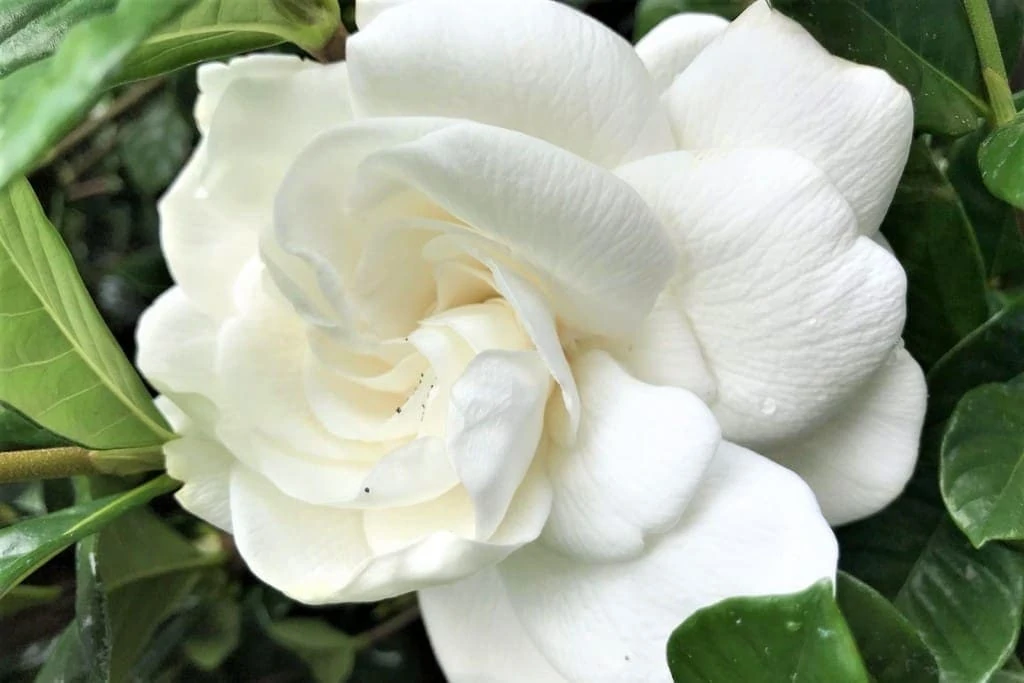by Amanda Rose Newton
Gardenias are known for their intoxicating scent that lingers in the air during our warmer Florida months. This unique scent has been known to trigger distinctive moments of our lives and for some, act as a time capsule for cherished memories.
Perhaps that is why gardenias are often given as gifts or planted in a special family member’s honor. If you are the lucky recipient or simply just looking to plant an old favorite, the gardenia will delight for seasons to come.

Gardenia Varieties
When it comes time to plant your gardenia, it is important to know whether yours has been grafted. Grafted trees will feature an abrupt change in the color, texture, or circumference of the trunk less than a foot above the soil. Grafting allows for the use of nematode-resistant rootstock, which enables gardenias to thrive in our sandy soil. A non-grafted gardenia is better off staying in a container than being put into the ground.
Both the spectacular Miami Supreme and the Tahitian gardenia are grafted showstoppers known for their large flowers and ability to be grown as small trees. If you are looking for giant flowers, the Cape Jasmine gardenia features dessert-plate sized blooms which make it an excellent focal point. Most gardenias will reach a height of 6-10 feet tall, but there are options for every landscape. The button gardenia, a nongrafted variety, will only reach 3 feet, making it perfect for showy containers.
Location, Location, Location
Gardenias are a bit fussy in their requirements for an idea spot, but the fragrance and blooms are worth the effort. They require at least 5 hours of sun a day, so you can get away with putting it in light shade. Starting with well-drained, organic-rich, low pH soil is the best way to ensure success from the start. Our soil here in Florida tends to run on the higher side of the pH scale, so make sure to fertilize with an organic low pH food, such as Espoma Holly-tone to naturally bring it down. Those beachside should note that the gardenia will not tolerate excess salt and needs to be protected from ocean spray.
The Perfect Spot for Gardenias
Once you have found your ideal spot, you will want to place the gardenia in the ground at the same level as the soil was in the pot. You can use 1-part Rockledge Garden’s planting mix and 1-part existing soil to backfill the hole. Add a cup of organic fertilizer such as Espoma Biotone to give roots a boost.
Ensure that you follow our instructions for watering new plantings and keep to the schedule. Gardenias tend to be excellent communicators and will display yellow leaves or dropped buds occasionally in the instance of under or overwatering.
Uninvited Guests – Gardenia Pests
Unfortunately, we are not the only ones entranced by their strong scent. Whiteflies, mealybugs, thrips, scales, and even the occasional beetle will be drawn to gardenias. Except for thrips and beetles, the rest are after plant sap, which leads to wilting, shriveling, and reduction of health of your gardenia. You might also see a black mold growing on the tops of the leaves, which is growing on the “honeydew”, a cute word for insect poop, left behind from the sap-feeders. The mold will vanish once the pest situation is taken care of.
All Season’s Oil spray is effective at eliminating the insects (make sure you spray underneath the leaves) as well as breaking up the mold for easier removal. Be sure to spray later in the day to avoid cooking your plant!
Feeding and Pruning Gardenias
Gardenias love lower pH soil, so to keep our alkaline sandy soil up to their liking, we recommend fertilizing once every 3 months with organic Espoma Holly-Tone.
For those intimidated by the idea of having to prune back a shrub, gardenias only require one good session a year. Ideally, this should be done after gardenias have put out their last blooms of the season. Shaping helps initiate healthy new growth and promotes enhanced blooming in the years to come.
There really is not a shrub as enchanting as a gardenia. Even when not in bloom, the dark glossy leaves offer a splash of richness to any landscape. Create a sensory sensation in your own garden and allow it to serve as a reminder of great memories past and those to come.


